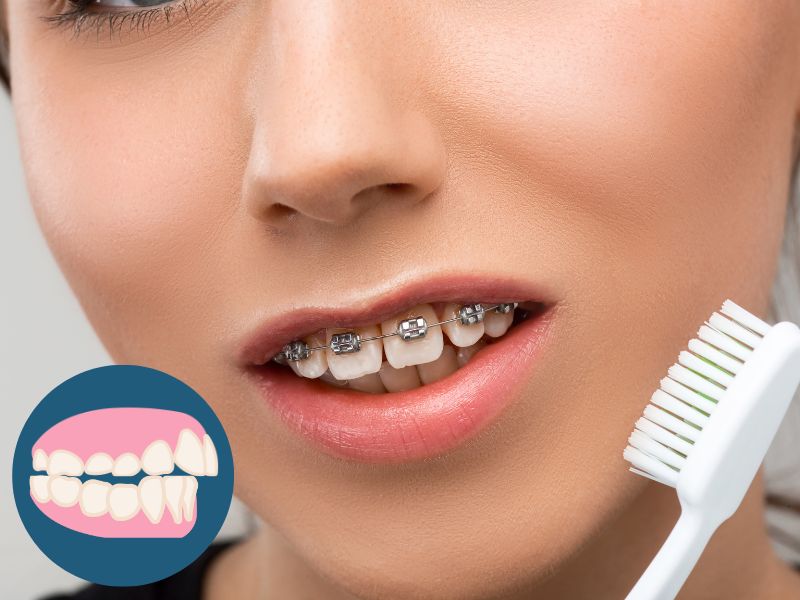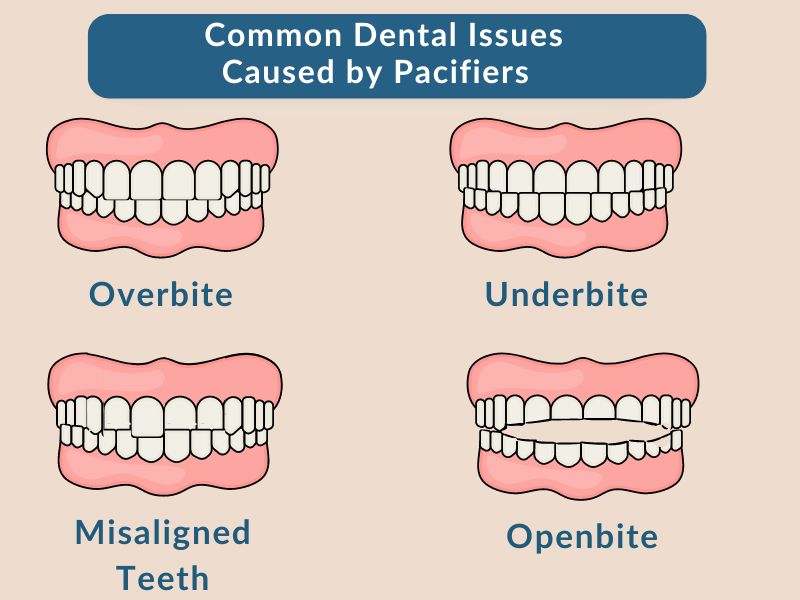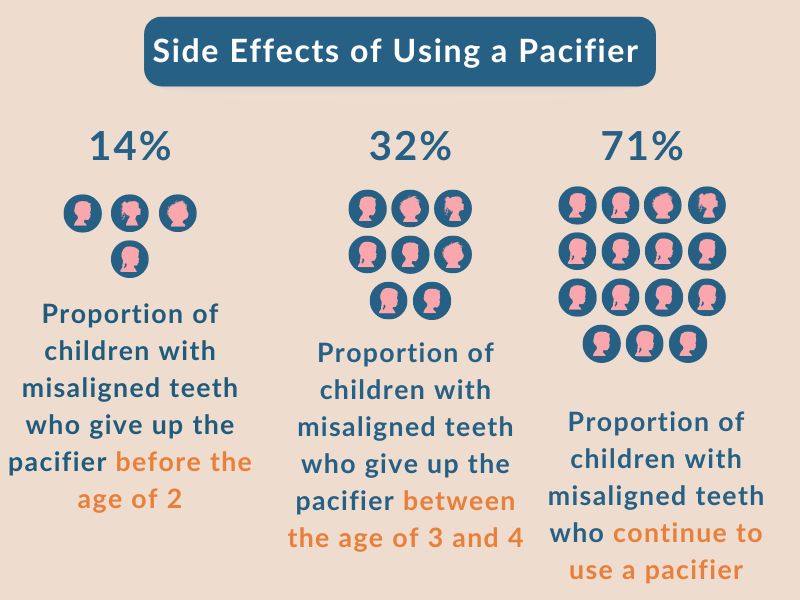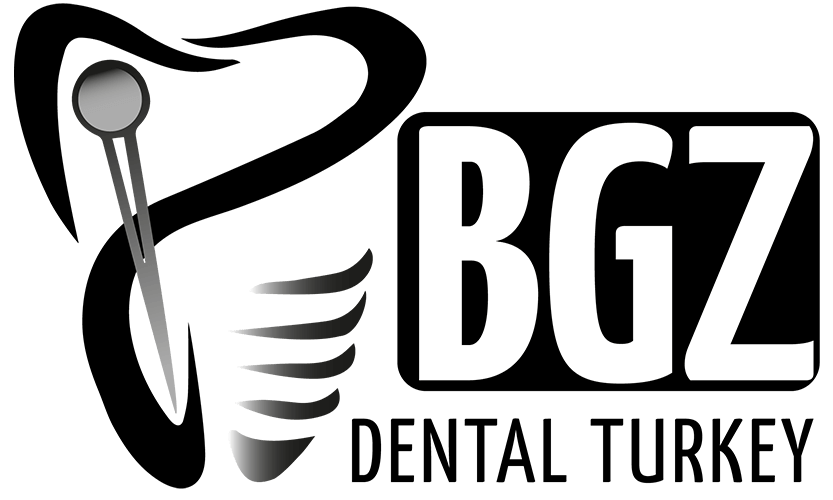
Pacifiers can be a parent's best friend, offering a quick way to soothe a fussy baby. However, prolonged use of pacifiers or thumb-sucking can lead to dental issues commonly called "pacifier teeth." In this comprehensive guide, we'll explore what pacifier teeth are, how they can affect your child's oral development, and the steps you can take to fix and prevent them. We'll also delve into recent technological advancements in dental treatments that offer effective solutions.
What are pacifier teeth?
Pacifier teeth refer to dental misalignments and abnormalities that develop in children due to extended use of pacifiers or prolonged thumb-sucking. The continuous sucking motion can interfere with the natural alignment of teeth and the proper growth of the jaw and palate. This can lead to various forms of malocclusion, which is the misalignment of teeth when the jaws are closed.
Common signs of pacifier teeth include an open bite, where the upper and lower front teeth do not meet when the mouth is closed, and an overbite, where the upper front teeth protrude over the lower teeth. These misalignments can affect not only the appearance of a child's smile but also their ability to chew properly and speak clearly.
Teeth development begins in the womb and continues throughout childhood. Anything that remains in a child's mouth for extended periods can impact this delicate process. The intensity and duration of the sucking habit play significant roles in determining the severity of dental issues that may develop.

Common dental issues caused by pacifiers and thumb-sucking
- Overbite (Buck Teeth): The upper front teeth protrude over the lower teeth.
- Open Bite: The upper and lower teeth do not touch when the mouth is closed, leaving a gap.
- Crossbite: The upper teeth bite inside the lower teeth on one side.
- Speech Impediments: Misaligned teeth can affect tongue placement, leading to difficulties in speech.
The intensity and duration of the sucking habit play significant roles in the severity of these conditions. The earlier the habit is broken, the better the chances of natural correction.
How to choose the right pacifier?
Selecting an appropriate pacifier can mitigate some of the risks associated with pacifier teeth. Here are some tips to help you make the right choice:
- Opt for Orthodontic Pacifiers: These are designed to support the natural development of the baby's palate, teeth, and gums.
- Choose the Correct Size: Pacifiers come in different sizes tailored to various age groups. Using the right size reduces the risk of dental issues and choking hazards.
- Avoid Multi-Piece Pacifiers: Pacifiers that come apart can pose a choking risk if pieces become detached.
- Check for Safety Standards: Ensure the pacifier meets British safety standards for baby products.
While the right pacifier won't eliminate all risks, it can significantly reduce the likelihood of developing pacifier teeth.
Can pacifiers affect permanent teeth?
Yes, prolonged pacifier use can affect not only baby teeth but also the development of permanent teeth. The use of a pacifier beyond the recommended age can lead to alterations in the structure of the jaw and dental palate. This can result in a narrowing of the dental arch, which affects how permanent teeth erupt and align.
A narrow dental palate can lead to overcrowding of permanent teeth, causing misalignment issues that may require orthodontic treatment later in life. Additionally, changes in the jaw structure can impact facial aesthetics and function, potentially leading to issues with chewing, speech, and even breathing.
It's important to understand that while baby teeth are temporary, they play a crucial role in holding space for permanent teeth. Damage or misalignment of baby teeth can have a cascading effect on the development of adult teeth.

Side effects of pacifiers on baby's teeth
While pacifiers can be beneficial in soothing infants, their prolonged use comes with several potential side effects on dental health.
Dental arch narrowing
Extended pacifier use can interfere with the natural development of the dental arch. The constant pressure exerted by sucking can cause the upper jaw to become narrow. This narrowing can lead to crowded teeth, as there isn't enough space for them to align properly. It can also affect the shape of the face and contribute to breathing disorders, such as sleep apnoea, due to reduced airway space.
Malocclusions
Malocclusions refer to misalignments of the teeth and improper fitting of the upper and lower jaws. Common malocclusions caused by prolonged pacifier use include:
- Open Bite: The upper and lower front teeth do not touch when the mouth is closed.
- Overbite: The upper front teeth excessively overlap the lower front teeth.
- Crossbite: The upper teeth bite inside the lower teeth, which can occur on one or both sides of the mouth.
These conditions can affect chewing efficiency, speech development, and increase the risk of tooth decay due to difficulty in maintaining proper oral hygiene.
Speech problems
The alignment of teeth and the position of the jaw play significant roles in speech development. Misaligned teeth can affect tongue placement, leading to articulation issues. Children may have difficulty pronouncing certain sounds, which can impact their communication skills and self-confidence.
Cavity and gum loss
- Some parents may dip pacifiers in sweet substances like sugar or honey to encourage their child to use them. This practice significantly increases the risk of tooth decay and gum disease. Sugars promote the growth of bacteria that produce acids, which can erode tooth enamel and lead to cavities. Additionally, prolonged exposure to sugars can cause inflammation and infection of the gums.
How to fix pacifier teeth?
If your child has developed pacifier teeth, several effective treatments are available. The choice of treatment depends on the severity of the condition and the child's age.
Braces and invisible aligners
Braces
Traditional braces are commonly used to correct complex dental misalignments:
- Metal Braces: These consist of metal brackets and wires; they're durable and effective.
- Ceramic Braces: Less noticeable than metal braces but function similarly.
Invisalign
Clear aligners are a discreet alternative:
- Custom-Made Trays: Aligners are tailored to fit your child's teeth.
- Removable: They can be taken out during meals and brushing.
- Comfortable: Smooth plastic reduces irritation compared to metal braces.
Recent Advancements: Digital scanning and 3D printing have improved the precision and comfort of aligners, making them more effective for younger patients.
Tongue crib
A tongue crib is a fixed appliance placed in the mouth:
- Purpose: Prevents the tongue from pushing against the teeth, which can exacerbate an open bite.
- Duration: Typically worn for several months to a year.
- Benefit: Helps eliminate thumb-sucking or tongue-thrusting habits.
Technological Development: Modern tongue cribs are designed to be more comfortable and less intrusive, encouraging better compliance from children.
Palatal expanders
Palatal expanders are devices that widen the upper jaw:
- Function: Applies gentle pressure to the upper molars to expand the palate.
- Benefits: It creates space for crowded teeth and corrects crossbites.
- Duration: Usually worn for a few months.
Advancement: New expanders are more adjustable and comfortable, allowing for precise control over the expansion process.
Surgery
In severe cases, surgical intervention might be necessary:
- Orthognathic Surgery: Corrects significant jaw misalignments.
- Tooth Extraction: Removes severely misaligned teeth to make space.
Note: Surgery is generally a last resort, considered only when other treatments are ineffective.
How can i prevent them?
Preventing pacifier teeth is easier than correcting them. Here are some steps you can take to minimise the risk.
Limit pacifier use
The American Academy of Pediatric Dentistry recommends weaning children off pacifiers by the age of three, but it's beneficial to start the process earlier. Reducing pacifier use around the age of two can significantly decrease the likelihood of developing dental issues.
Encourage alternative soothing methods
Introduce other comfort objects like soft toys or blankets. Reading stories, singing lullabies, or gentle rocking can also soothe your child without the need for a pacifier.
Monitor thumb-sucking
If your child resorts to thumb-sucking after giving up the pacifier, it's essential to address the habit promptly. Gentle reminders and positive reinforcement can help discourage this behaviour.
Regular dental check-ups
- Schedule your child's first dental visit by their first birthday. Regular check-ups allow for early detection of potential issues and provide an opportunity for professional guidance on oral habits.
So, what happens when you get rid of the pacifier but your child sticks to thumb-sucking?
Thumb-sucking can be a more challenging habit to break since, unlike a pacifier, the thumb is always available. Children often use thumb-sucking as a coping mechanism to soothe anxiety or stress.
Addressing the psychological aspect is crucial. Talk to your child about their feelings and offer comfort and reassurance. Create a supportive environment where they feel secure. Positive reinforcement is more effective than punishment. Praise your child for not sucking their thumb and consider using reward systems to encourage the desired behaviour.
If the habit persists, consider covering the thumb with a bandage or sock during sleep times. In some cases, a dentist may recommend a mouth appliance that makes thumb-sucking less pleasurable.
What to do if your child has developed pacifier teeth
If you suspect your child has pacifier teeth, consult a paediatric dentist promptly. Early assessment can determine the extent of the misalignment and the best course of action.
The dentist may refer you to a paediatric orthodontist, who specialises in correcting dental issues in children. Treatment options may include the orthodontic appliances mentioned earlier, such as braces, aligners, tongue cribs, or palatal expanders.
Early intervention increases the chances of successful treatment and can prevent more severe issues from developing. The dentist can also provide guidance on breaking the pacifier or thumb-sucking habit, which is essential for preventing further damage.
Why should i replace a pacifier every three months?
Pacifiers undergo wear and tear, especially with regular use. Over time, the material can weaken, develop cracks, or change in texture. Damaged pacifiers pose several risks:
- Hygiene Concerns: Cracks and holes can harbour bacteria and fungi, increasing the risk of oral infections like thrush.
- Choking Hazards: Small pieces may break off and become a choking hazard.
- Ineffectiveness: A worn-out pacifier may not provide the same level of comfort or may cause discomfort.
Regularly replacing the pacifier ensures it's in good condition and safe for your child to use. Always inspect the pacifier before giving it to your child, and discard it if you notice any signs of damage.
How to fix pacifier teeth in adults?
Adults who experienced prolonged pacifier use or thumb-sucking in childhood may still have residual dental issues. Fortunately, modern dentistry offers solutions to correct these problems.
Orthodontic treatment
Braces and invisible aligners are effective in realigning teeth and correcting bite issues in adults. While treatment may take longer than in children due to the maturity of the bone structure, advances in orthodontic technology have made treatments more efficient and comfortable.
Veneers
For cosmetic improvements, dental veneers can be an option. Veneers are thin shells made of porcelain or composite resin that are bonded to the front surfaces of teeth. They can improve the appearance of teeth that are chipped, discoloured, or slightly misaligned.
Surgical options
In cases involving significant jaw misalignment, orthognathic surgery may be necessary. This procedure realigns the jaws to improve function and aesthetics. It's usually performed in conjunction with orthodontic treatment.
Consulting with a dental professional is essential to determine the most appropriate treatment plan based on individual needs.
Are pacifiers good or bad?
Pacifiers have both advantages and disadvantages. Understanding these can help you make informed decisions about their use.
Pros
- Soothing Effect: Pacifiers can calm a fussy baby, providing comfort and aiding in sleep.
- Reduced Risk of SIDS: Some studies suggest that pacifier use during sleep may lower the risk of sudden infant death syndrome.
- Pain Relief: Sucking on a pacifier can help alleviate discomfort during procedures like vaccinations.
- Premature Infants: Pacifiers can stimulate the sucking reflex in preterm babies, aiding in feeding development.
Cons
- Dental Issues: Prolonged use increases the risk of developing pacifier teeth and other malocclusions.
- Dependency: Babies may become reliant on pacifiers for comfort, making it challenging to wean them off.
- Ear Infections: Extended use can affect the function of the eustachian tube, increasing the risk of middle ear infections.
- Interference with Breastfeeding: Early introduction of pacifiers may lead to nipple confusion and impact breastfeeding success.
- Hygiene Concerns: Pacifiers can harbour bacteria and fungi if not cleaned properly, leading to infections.
Balancing the benefits and risks is key. Limiting pacifier use and adhering to recommended guidelines can help maximise benefits while minimising drawbacks.
How to clean a pacifier?
Proper cleaning of pacifiers is crucial to prevent the spread of germs and maintain your child's oral health.
- Before First Use: Sterilise the pacifier by boiling it in water for at least five minutes. Allow it to cool completely before giving it to your child.
- Daily Cleaning: Wash the pacifier with warm, soapy water after each use. Rinse thoroughly to remove any soap residue.
- Regular Sterilisation: Boil the pacifier or use a steam steriliser periodically to ensure it's free from bacteria and fungi.
- Avoid Harsh Chemicals: Do not use bleach or other harsh cleaning agents, as they can leave harmful residues.
- Inspect for Damage: Regularly check for cracks, tears, or changes in texture. Replace the pacifier if any damage is found.
Maintaining good hygiene practices reduces the risk of infections and ensures the pacifier remains safe for use.
When can i stop giving my baby a pacifier?
Experts recommend weaning your child off the pacifier between the ages of six months to one year. This timing aligns with the period when the risk of sudden infant death syndrome decreases, and before the habit becomes deeply ingrained.
Weaning earlier can also reduce the likelihood of dental issues and ear infections. The process should be gradual to minimise stress for both the child and the parents. Start by limiting pacifier use to sleep times and slowly phase it out completely.
Consult your paediatrician or paediatric dentist for personalised advice and strategies tailored to your child's needs.
Conclusion
Pacifiers can be a helpful tool in parenting, providing comfort and aiding in the early development of infants. However, it's essential to use them responsibly to avoid potential dental issues like pacifier teeth. Understanding the risks associated with prolonged use and taking proactive steps can safeguard your child's oral health.
If your child has developed pacifier teeth, early intervention is crucial. Consult dental professionals to explore treatment options and implement preventive measures. With the right approach, you can ensure your child maintains a healthy, beautiful smile as they grow.
With our guaranteed treatments, we are always here for you.
Don’t hesitate to contact us, We will be happy to help anytime.



